You can level and putty the surface of the floor slab, make a structure of drywall, but the top layer is still painted with decorative compounds. Ceiling emulsion paint is applied evenly, tinted in the desired color and becomes an attribute of modern finishes. The water emulsion will help to renew the old coating on the ceiling, making it a full-fledged part of the new interior.
Rules for choosing water-based paint
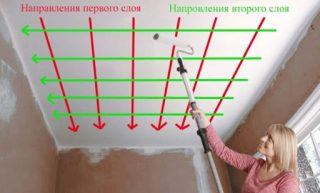
The formulations, after drying, form a glossy or matte surface. The first type forms a lot of glare, due to this, the unevenness of the putty is immediately striking. The reflective ceiling visually increases the height of the room, easy to clean. The matte layer, on the contrary, does not show any flaws, but it looks deaf and heavier.
The spaciousness of the room will give the light color of the top covering, which is always paler than the floor, and the color of the walls remains in the middle position. The color of the ceiling is chosen by the homeowner at will, taking into account the peculiarities of the interior.
Popular compositions for painting the ceiling with water-based paint are:
- acrylic paints;
- latex compounds;
- based on polyvinyl acetate;
- silicone-based;
- with minerals in the composition.
All paints create strong films that dry quickly. Steam and vapors rise to the ceiling, therefore, the coating is in conditions of high humidity, in the zone of action of fats and acids (kitchen).
Emulsion paints meet the requirements for resistance to the harmful effects of the surrounding space.
Acrylic
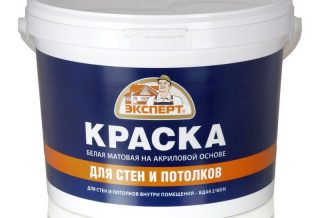
The category includes water-dispersion compositions based on methyl, ethyl and butyl acrylates (polyacrylates), resins. The appropriate copolymers are added to form a film. The paint is diluted with water before work, but it is recommended to add no more than 10%, since the hiding power of the material will decrease. After film formation, such surfaces show resistance to moisture.
Advantages of acrylic coating:
- environmentally friendly material, there is no smell when working, people do not show allergies during application and use;
- ease of work with paint, ease of application, quick setting;
- resistance against ultraviolet radiation, temperature surges;
- the possibility of cleaning with soap and detergents;
- a large selection of manufacturers, brands, colors and compositions.
When dry, the tone of the pigment becomes a little darker, so they make a test color, wait a day.
Acrylic adheres well not only to the putty surface, it is used to paint plastic panels on the ceiling or foam tiles.
Acrylic with latex
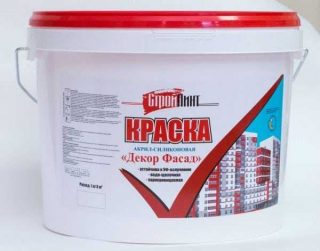
Modern industry does not use natural rubber for the manufacture of latex paint in order to reduce the cost. Manufacturers take inexpensive synthetic polymers and make a liquid-based polymer composition.
Types of latex formulations:
- Styrene-butadiene. Indicators of moisture resistance and strength are average, but the composition is also recommended for interior painting. It is not recommended to paint a balcony slab or ceiling on a cold veranda below.
- Acrylosilicone.The high-quality composition allows you to cover the surface in the bathroom, kitchen. The material resists wear and tear, does not lose its tonality from the rays of the sun.
After evaporation of moisture from the surface, the latex particles bind together and form a strong film. Latex compounds are applied with a roller, brush, resulting in a durable coating. When buying, find out the quality characteristics of wear specified by the manufacturer. For ceilings, paint is taken with abrasion of about 1 thousand cycles, and the walls are painted with a material with a high indicator.
Based on polyvinyl acetate
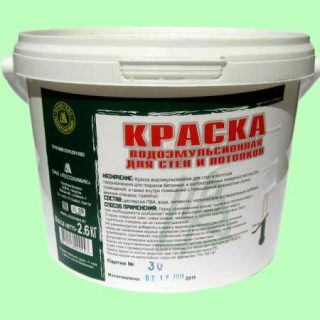
The PVA-based material is cheap, easy to apply. The composition does not tolerate high humidity, it should not be used in bathrooms. Designed for interior use, resulting in matte finishes.
It dries up in a couple of hours, when using the pigment, any color from faded to rich-bright is obtained. Surfaces can be wiped with a damp cloth; such a coating reacts weakly to soap solutions. Can be used for ceiling surfaces previously painted with various compounds, for example, oil or pentaphthalic.
Copper sulfate or products based on it are not used as a primer before work. Such a layer forms inseparable chemical bonds with polyvinyl acetate, which impair the characteristics of the future paint layer. One-component formulations are diluted with water in small volumes.
The bank indicates the consumption of material per square meter. This indirectly characterizes the hiding power, since consumption also depends on the quality of the surface (plaster, putty).
With silicone or silicate base
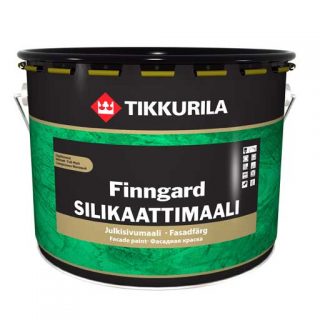
Such a paint and varnish material is a suspension of talc, crushed quartz, tripoli, diatomite or separated chalk (fillers and pigments with resistance to alkalis). Calcium borate and zinc oxide powder act as silicates; potassium glass is also introduced. For staining, take metallic red lead or ocher.
Paint grades depend on the type of silicate:
- category A - contains compositions with dry whitewash;
- B - has calcium borate.
Silicate compounds are packed in two containers for dry components and liquid glass. Mix in a ratio of 1: 2 by weight. Silicate compounds are dissolved with water, they are non-toxic and form vapor-permeable films that are resistant to temperature changes, increased humidity.
Silicone materials are used for indoor painting, they are used to cover ceilings in cold rooms. Suitable formulations for painting wood top coatings and decorating beams.
The paint applied over the plaster increases the resistance to the atmosphere. This is due to the fact that the components react with the released calcium hydroxide in the cement-sand mortar.
With a mineral composition
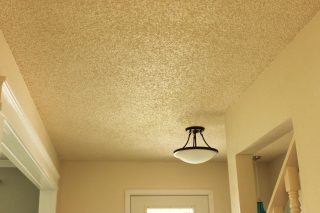
Such materials are supplemented with inorganic substances obtained using natural raw materials, as well as industrial waste and minerals. Powder compositions diluted with water, after drying, have a pronounced relief surface. They are used to decorate individual sections of the ceiling or to paint over the entire area.
Such coatings are applied only at positive temperatures. The film is vapor permeable, therefore it regulates the moisture content of the floor slab and prevents its destruction.
- Lime compositions. Slaked lime or milk acts as a binder. To increase the moisture resistance, calcium chloride, aluminum alum, and salt are introduced. Pigmented with inorganic substances with a predominance of light tones.
- Cement paints. The binder is colored or white Portland cement, dyes resistant to alkali. Increase resistance to moisture with calcium chloride and hydrated lime (15%).Waterproof materials are used for the ceiling in bathrooms, saunas, baths.
After application, mineral compositions with cement are moistened for some time so that a network of small cracks does not appear.
Features of painting the ceiling with water-based paint

To properly paint the ceiling with water-based paint without streaks, you need to do some preparation, then do the work taking into account professional advice.
A common mistake is that the user saves on the cost of paint. Cheap formulations have poor coverage of the surface, sometimes the first layer almost does not cover the stains from the primer, which can have a gray or dull yellow color. Relying on one volume of paint, you have to increase the quantity and purchase additional cans. Part of the labor costs increases, because instead of 1 - 2 layers, 4, sometimes 5 are imposed.
From the ends of the roller nozzles, the pile is cut off on the sides, reducing the length at the corners. This is necessary so that strips of excess paint do not remain during rolling. Such protruding lines will be with each next movement; it is difficult to get rid of them if you do not cut off the hairs.
Required tools and materials
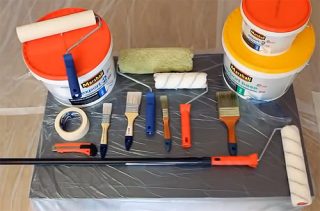
Ceiling brushes are almost never used. Stripes remain from them, since water-based paint is almost always thick, and it can only be diluted with water in a certain proportion. Therefore, for priming, painting, a roller is taken, which facilitates the work and improves the quality of application.
To prepare you need:
- wide and narrow spatulas;
- a drill with a mixer for mixing the putty;
- diamond meshes (No. 60, 120, 240) and a trowel.
Coloring is carried out by diluting the composition directly in the cuvette. The nozzle is taken so long that it fits into the bath. With the help of a large roller, a lot of paint is collected, therefore, from one parking lot it is possible to process a significant area of the ceiling without transitions.
From materials you will need soil, paint. The preparation is done with putty, the starting one is equal to large differences, and the finishing option is used for the final layer. Work is carried out from a stepladder or scaffold, you can use a table.
Preparatory work
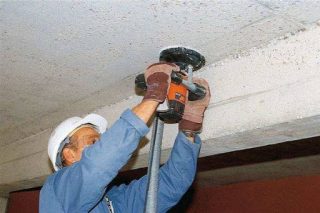
The surface is cleaned of dust, old layers are removed, then primed before the first layer of putty. All layers that are applied and leveled with emery must be soaked with soil to increase adhesion. To get a smooth ceiling, you need to carefully putty the surface to perfect condition.
Swelling of paint and its hanging from the ceiling in the form of a shell appears if, after grinding the putty layer, the surface of the ceiling was not over-primed. The composition is applied with a roller or spray gun, since brush marks will be visible on the surface, and they will appear after painting. One layer of soil is enough, but they start painting after it dries (6 - 8 hours).
If ceiling friezes are provided, they are placed in the putty process, then the joints are sealed so that there are no cracks and irregularities.
Painting is done together with moldings, separately painting them with a brush.
DIY ceiling painting
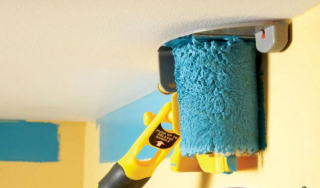
I start from the corner of the ceiling. First, paint the areas next to the frieze with a roller, then tint those areas with a brush where it did not reach.
Technological moments:
- all the stripes of paint that appear are rolled out at once, since the material sets quickly;
- they try to apply the composition evenly, in one parking lot they roll it out with a roller in all directions from the center (away from themselves);
- drafts do not directly affect the strength of the layer, but they accelerate drying, which is harmful during joining of adjacent areas;
- with a short break, the roller is closed in a plastic bag; for a long stop (overnight), it is better to wash the nozzle or place it in a container with water (completely).
You can paint without a scaffold; for this, extension nozzles are sold on the roller handle.The danger is that it is difficult to see errors from this distance, or to notice them when the paint is already dry.
It is advisable to work during the day, since all flaws are visible in natural light. If it's already dark, you need to take a portable lamp and illuminate the surface with it in different areas.








